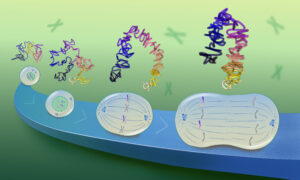
Buffering mechanism protects embryonic development
EMBL scientists uncover buffering mechanisms that protect an embryo's development from detrimental effects of genetic variation

EMBL scientists have pinpointed thousands of potentially functional genetic variants that disrupt gene regulation during embryonic development. The findings, published in Nature, reveal buffering mechanisms that cancel out detrimental effects of genetic variation during embryonic development.
Summary
– Study of how genes are regulated during embryonic development in the fruit fly reveals thousands of genetic variants that disrupt molecular processes.
– Findings show that some of these variants have a severe effect on the regulation of gene expression, but thanks to the presence of ‘buffering’ variants that cancel out these effects, they are tolerated within healthy individuals.
– Results demonstrate that such interactions are very common, and have been under-appreciated.
Background
People are not so different from one another genetically, but small differences in their genome sequence can play a big part in whether one person is more susceptible to a disease than another.
“You might think that these little changes in the sequence are found in our genes, but they’re actually located in this vast sea of DNA that doesn’t seem to be a ‘blueprint’ for making things like RNA or proteins,” explains EMBL’s Eileen Furlong, who co-led the study. “That sea actually represents the bulk of our genome, and finding which changes are essential to life, or cause specific traits, is a huge challenge.”
What they did
Researchers from EMBL in Heidelberg, Germany and EMBL-EBI in Hinxton, UK studied natural differences between the genetic makeup of individuals, exploring how genetic variation affects the expression of genes (whether and when they were turned on or off) during three stages of embryonic development. To do so, they designed a large-scale approach that drew on several scientific disciplines: population genetics, developmental biology, genomics and computational biology.
They used the model organism Drosophila, as it has very high genetic diversity and there is a wealth of knowledge about how its development is regulated. The parents of these embryos represented 80 different genetic backgrounds, approaching the diversity of a ‘wild’ population.
What they found
“We demonstrated that if you measure genetic variation in a large enough sample, you can pinpoint the causal genetic variants – the ones that disrupt different molecular steps in the control of how genes are regulated, and can thereby lead to developmental defects,” says Furlong.
Regardless of this extensive [genetic] variation, the embryo can still develop normally.
“The data is very exciting. This is the first time we can see–at a population level, in any species–the effect of genetic variation on gene expression during embryonic development,” adds Nils Kölling, an EMBL-EBI computational PhD student on the project. “The project also involved developing new, state-of-the art, computational analyses so others can continue to build on this work.”
“The resolution is truly remarkable,” says Enrico Cannavò, an EMBL PhD student who led the experimental work. “We could identify the location of hundreds of new regulatory elements in the vast non-coding regions of the genome, which is a big achievement in itself. But we were also able to zoom in to the affected DNA sequence ‘motifs’ within them, which lets us start to develop a picture of how variation impacts developmental programs.”
After a gene is expressed it produces RNA, which goes through several steps of processing. Genetic differences among individuals can also affect these regulatory steps, leading to variation in gene expression between individuals.
“Our data also uncovered new functional DNA motifs that are essential for carrying out these steps, which should spark many new studies into how these motifs are used,” says Dermot Harnett, an EMBL PhD student who drove this part of the analyses.
Why it matters
“This study leverages the high genetic diversity in Drosophila to pinpoint causal non-coding variants – something that’s hard to do humans,” says Ewan Birney of EMBL-EBI, who co-led the study. “Even more importantly, it gives us a window into how genetic variation might play out during embryonic development – something that’s almost impossible to study in humans.
“Obtaining this level of genetic diversity in human studies is still a ways off, but this work is a proof of principle for how one may pinpoint causal disease variants in humans by examining tens of thousands of individuals.”
The researchers found that regardless of this extensive variation, the embryo can still develop .
“I find this aspect of the study very exciting, because the ‘programs’ that regulate the development of an embryo can buffer these effects somehow,” adds Furlong. “Interestingly, when you see genetic variants that have a big effect on how genes are expressed, on a population level, you’ll also see other variants that dampen these effects. That buffering is called genetic epistasis, and there is a lot of research going on now into how it works. We discovered one important context where this is achieved.”
What’s next?
The next step for the team is to build on this resource and expertise, following the same principles to study how genetic diversity affects other molecular traits. One of these traits is diversity amongst gene promoters, which initiate the first steps of converting a gene into RNA. This will give insights into how differences in phenotypes between individuals arise.
This post was originally published on EMBL-EBI News.


